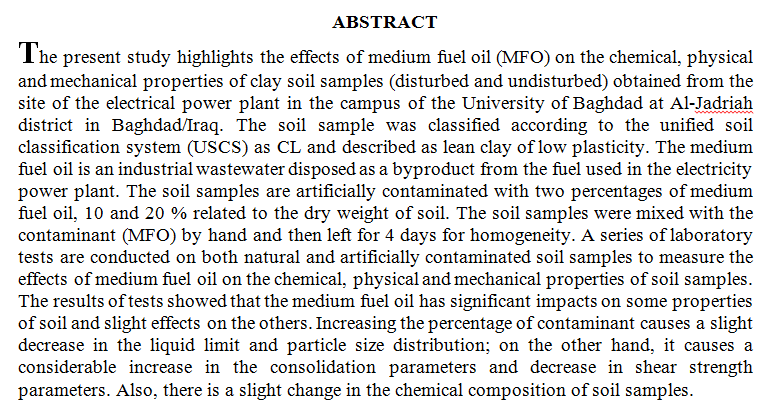
 (13)
(13)
 (10)
(10)
In this study miconazole nitrate was formulated as topically applied emulgel; different formulas were prepared using sodium carboxymethylcellulose (SCMC) and carboxypolymethylene (carbomer 941) as gelling agents. The influence of type of gelling agent and concentration of both oil phase and emulsifying agent on drug release was studied and compared with commercially available miconazole nitrate cream (Mecozalen®). The results of in vitro release showed that SCMC emulgel bases gave better release than carbomer 941 bases and the release of drug increase from both bases as a function of increasing the concentration of emulisifying agent. The oil phase had retardation effect when
... Show More (6)
(6)
Waste materials might be utilized in various applications, such as sustainable roller compacted concrete pavements (RCCP), to lessen the negative environmental consequences of construction waste. The impacts of utilizing (brick, thermostone, granite, and ceramic) powders on the mechanical characteristics of RCCP are investigated in this study. To achieve this, the waste materials were crushed, grounded, and blended before being utilized as filler in the RCCP. After the mixes were prepared, compressive strength, splitting tensile strength, flexural strength, water absorption, density, and porosity were all determined. According to the research results, adding some of these powders, mainly brick and granite powder, enhances the mechanical
... Show More (5)
(5)
Gallium arsenide diamondoids structural and vibrational properties are investigated using density functional theory at the PBE/6-31(d) level and basis including polarization functions. Variation of energy gap as these diamondoids increase in size is seen to follow confinement theory for diamondoids having nearly equiaxed dimensions. Density of energy states transforms from nearly single levels to band structure as we reach larger diamondoids. Bonds of surface hydrogen with As atoms are relatively localized and shorter than that bonded to Ga atoms. Ga-As bonds have a distribution range of values due to surface reconstruction and effect of bonding to hydrogen atoms. Experimental bulk Ga-As bond length (2.45 Å) is within this distribu
... Show More (10)
(10)
 (9)
(9)
n this study, Cr−Mo−N thin films with different Mo contents were synthesised via closed field unbalanced magnetron sputtering ion plating. The effects of Mo content on the microstructure, chemical bonding state, and optical properties of the prepared films were investigated by X-ray diffraction spectroscopy (XRD), X-ray photoelectron spectroscopy (XPS), field emission scanning electron microscopy, and ultraviolet-visible spectrophotometry. XRD results determined the face centered cubic (fcc) structure of pure CrN film. The incorporation of molybdenum (Mo) in the CrN matrix was confirmed by both XRD and XPS analyses. The CrMoN coatings demonstrate various polycrystalline phases including CrN, γ-Mo2N, Cr with oxides layers of MoO3, CrO3,
... Show MoreABSTRACT: Thin film of CdS has been deposited onto clean glass substrate by using Spray pyrolysis technique. Results of Morphological (AFM) studied; electrical properties and optical conductivity studied are analysis. AFM results show a crystalline nature of the films. From the conductivity measurement at different temperatures, the activation energy of the films was calculated and found to be between 0.188 - 0.124 eV for low temperature regions, and between 1.67-1.19eV for high temperature regions. Hall measurements of electrical properties at room temperature show that the resistivity and mobility of CdS polycrystalline films deposited at 400 C0, were 3.878x103 . cm and 1.302x104cm2/ (V.s), respectively. The electrical conductivity of th
... Show MoreZnS:MnP2+P nanoparticles were prepared by a simple microwave irradiation method under mild condition. The starting materials for the synthesis of ZnS:MnP 2+P quantum dots were zinc acetate as zinc source, thioacetamide as a sulfur source, manganese chloride as manganese source (R & M Chemical) and ethylene glycol as a solvent. All chemicals were analytical grade products and used without further purification. The quantum dots of ZnS:MnP 2+P with cubic structure were characterized by X-ray powder diffraction (XRD), the morphology of the film is seen by scanning electron microscopy (SEM) also by field effect scanning electron microscopy (FESEM). The composition of the samples is analysed by EDS. UV-Visible absorption spectroscopy analysis
... Show MoreThe spectral characteristics and the nonlinear optical properties of the mixed donor (C-480) acceptor (Rh-6G) have been determined. The spectral characteristics are studied by recording their absorption and fluorescence spectra. The nonlinear optical properties were measured by z-scan technique, using Q-switched Nd: YAG laser with 1064 nm wavelength. The results showed that the optimum concentration of acceptor is responsible for increasing the absorption and the emission bandwidth of donor to full range and to 242 nm respectively by the energy transfer process, also the efficiency of the process was increased by increasing the donor and acceptor concentration. The obtained nonlinear properties results of the mixture C-480/ Rh-6G showed
... Show Morethis work, a simple method was used to prepare the MnO2 nanoparticles. These nanoparticles then were characterized by several techniques, such as X-ray diffraction, Fourier transform infrared spectroscopy, scanning electron microscopy (SEM) and atomic force microscope (AFM). The results showed that the diffraction peak of MnO2 nanoparticles was similar to that of standard data. The images of AFM and SEM indicated that the MnO2 nanorods were growing from the MnO2 nano spherical shape. PVA-pentaerythritol/MnO2 nanocomposite films were fabricated by evaporating casting method. The dielectric constant and loss tangent of P-Ery/MnO2 films were measured between 10 kHz and 1 MHz using LCR. As the content of MnO2 increased, the dielectric constant
... Show More